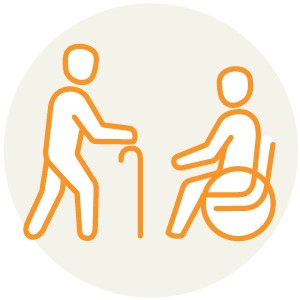Universal access
On this page
Universal design
The seven principles of universal design are:
(1) equitable use(2) flexibility in use
(3) simple and intuitive use
(4) perceptible information
(5) tolerance for error
(6) low physical effort (7) size and space for approach and use.
TMR endorsed guidance
- Accessibility and Inclusion Strategy (Department of Transport and Main Roads, 2020)
- Public Transport Conveyance Manual (TransLink, 2020)
Other useful resource
- Video of Universal Design of ICT (The Authority for Universal Design of ICT Norway, 2021)
Grades and surface treatments
While a footpath necessarily follows the natural topography of the area, in the best possible circumstances a continuous accessible path of travel should:
- have a gradient of no steeper than 1 in 20
- have a cross fall of no steeper than 1 in 40
- have kerb cuts with appropriate kerb ramps
- incorporate appropriate Tactile Ground Surface Indicators where necessary to ensure adequate safety and orientation at street crossings
- have a pedestrian zone with a minimum clear width of 1.8m at the narrowest point and a minimum clear height of 2 metres with nothing encroaching into that envelope
- be as smooth as possible without raised or cracked paving or tree root damage
- have a slip resistant surface during dry and wet conditions.
Useful resources
- Guide to Road Design Part 6A: Paths for Walking and Cycling, Sections:
- 5.6 Crossfall and Drainage
- 5.8 Changes in Level
- 5.9 Surface Treatments (Austroads, 2017)
- FAQ: Does the DDA Cover Access to the Footpath? (Australian Human Rights Commission, 2014)
- Inclusive Mapping Pilot Project (Department of Transport and Main Roads, 2020)
Kerb ramps
Ramps must be oriented in the direction of travel, not to the centre of the intersection. Absolute maximum slope is 1 in 8 (1 in 10 or flatter preferred). Provide TGSIs for people with vision impairments (see note G on KRG1 for when TGSI’s are not required).
TMR endorsed guidance
- TMR Standard drawings:
- SD1446 - Kerb ramp - Ramped kerb crossing
- SD1447 - Median and island crossing - Ramped and cut-through treatment for pedestrian facilities
- KRG1 - Kerb ramp - Guidelines for the installation of tactile ground surface indicators on ramped kerb crossings
- KRG2 - Kerb ramp - Application examples for the installation of TGSIs on ramped kerb crossings
- TMR Technical Training Courses: RPD308 Pedestrian Crossing Facilities and Tactile Ground Surface Indicators Design (one day)
- Fact Sheet: Motorised Mobility Devices (MMDs) and kerb ramps
- AS1428.1 – Design for access and mobility - New building work
Other useful resources
- Guide to Road Design Part 4: Intersections and Crossings – General, Section 8.2.3 Kerb Ramps for Pedestrians (Austroads, 2017)
- Road Safety Audit Tool for Pedestrians who are Vision Impaired (Burtt, 2014)
Tactile Ground Surface Indicators (TGSIs)
Tactile Ground Surface Indicators (TGSI) are discerned underfoot, by cane tip or by their contrasting colour. There are two types of TGSI:
- raised dots are hazard or warning indicators which indicate a nearby hazard – a grid of hazard bumps indicates the ground surface will be changing and a ramp, stairs or train platform edge may be imminent
- parallel raised lines are directional TGSI, which indicate the direction of travel.
TMR endorsed guidance
- TMR Standard Drawings:
- KRG1 - Kerb ramp - Guidelines for the installation of tactile ground surface indicators on ramped kerb crossings
- KRG2 - Kerb ramp - Application examples for the installation of TGSIs on ramped kerb crossings
- Compliant products register for Tactile Ground Surface Indicators (TGSI) (Department of Transport and Main Roads, 2020)
- AS1428.4.1 – Design for Access and Mobility – Tactile ground surface indicators
Other useful resources
- TMR Technical Training Courses: RPD308 Pedestrian Crossing Facilities and Tactile Ground Surface Indicators Design (one day)
- Road Safety Audit Tool for Pedestrians who are Vision Impaired (Burtt, 2014)
Audio tactile facilities
Audio tactiles are mechanical or electronic devices connected to the pedestrian ‘call button’ box on crossing poles that pulse (which can be detected by someone’s hand) and emit a ticking or beeping sound.
Audio tactiles are designed to synchronise with the slow clicking phase (when the red man is illuminated) and fast clicking phase (when the green man is illuminated) of traffic signals.
A ticking audio tactile device should be louder than ambient noise.
Push buttons for pedestrian activated signals and audio tactiles should be located within easy reach of the kerb ramp.
TMR endorsed guidance
- Queensland Manual of Uniform Traffic Control Devices Part 10: Pedestrian control and protection (Department of Transport and Main Roads, 2021)
- Queensland Manual of Uniform Traffic Control Devices Part 14: Traffic signals (Department of Transport and Main Roads, 2022)
- AS2353 Pedestrian Push-Button Assemblies
- AS1742 Manual of uniform traffic control devices Part 10: Pedestrian control and protection
- AS1742 Manual of uniform traffic control devices Part 14: Traffic signals, Section 5.6 Pedestrian push buttons and Section 6.2 Pavement markings
Other useful resources
- Guide to Traffic Management Part 9: Transport Control Systems – Strategies and Operations, Appendix H Pedestrian Push-button Location (Austroads, 2020)
- Road Safety Audit Tool for Pedestrians who are Vision Impaired (Burtt, 2014)
Legislation and guidance
- Legislation regulates organisations and individuals by making it unlawful to discriminate against a person because of protected attributes including age, disability, race and sex.
- Policy, strategy and planning documents provide guidance on how organisations can meet their legal obligations.
International:
- Convention on the Rights of Persons with Disabilities (United Nations, 2022)
Federal:
- Disability Discrimination Act (DDA) 1992
- Disability Standards for Accessible Public Transport (DSAPT) 2002
- Disability (Access to Premises - Buildings) Standards 2010
Queensland Government:
- Last updated 31 March 2023

